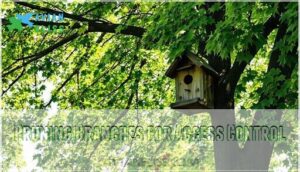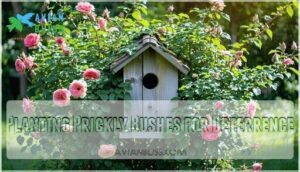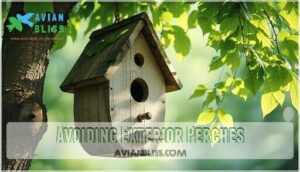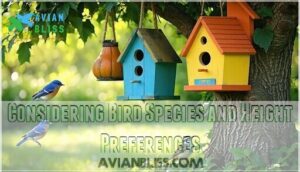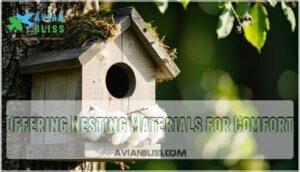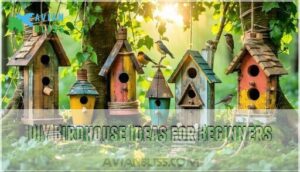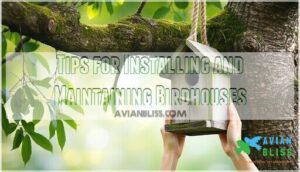This site is supported by our readers. We may earn a commission, at no cost to you, if you purchase through links.
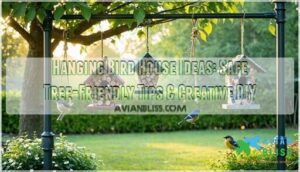 You’ll find countless hanging bird house ideas that transform your backyard into a feathered paradise.
You’ll find countless hanging bird house ideas that transform your backyard into a feathered paradise.
Use flexible wire or rope to protect tree bark, avoiding nails that damage the cambium layer.
Position houses 5-15 feet high, depending on your target species.
Face entrances away from prevailing winds, and skip exterior perches that welcome predators.
Try creative DIY options like repurposed flower pots, wine cork designs, or mosaic stone feeders for visual appeal.
Metal poles with predator baffles offer safer alternatives to trees.
Remember, proper placement matters more than fancy decoration.
The secret lies in understanding which mounting techniques actually keep your feathered friends coming back season after season.
Table Of Contents
- Key Takeaways
- Protecting Trees From Birdhouse Installation
- Hanging Bird House Ideas for Safety
- Choosing The Right Birdhouse Location
- Alternative Mounting Options for Birdhouses
- DIY Birdhouse Ideas for Beginners
- Tips for Installing and Maintaining Birdhouses
- Frequently Asked Questions (FAQs)
- How to hang a birdhouse?
- What are the best Birdhouse ideas?
- Why should you hang a birdhouse?
- Can You DIY a birdhouse?
- Can you hang a birdhouse on brick?
- How do you keep birds from nesting in a birdhouse?
- Do birds like hanging birdhouses?
- Is it OK to hang a bird house?
- Where is the best place to hang a bird house?
- What color birdhouse attracts birds the most?
- Conclusion
Key Takeaways
- You’ll protect trees by using flexible mounting methods like nylon straps or fabric fasteners instead of nails and screws, which damage the cambium layer and invite disease.
- You should position birdhouses 5-15 feet high facing east or southeast, away from prevailing winds, and use metal poles with baffles to keep predators from climbing up.
- You can create DIY birdhouses from repurposed materials like wine corks, flower pots, or teapots, but skip exterior perches since they give predators easy access to nests.
- You’ll increase nesting success by cleaning houses twice yearly, checking mounting stability regularly, and placing them near trees but away from feeders for optimal bird safety.
Protecting Trees From Birdhouse Installation
When you’re installing birdhouses on trees, you’ll need to protect the tree’s cambium layer, which carries nutrients between the roots and leaves.
Choose flexible mounting methods like wire or straps instead of screws or nails, since these damage the tree’s bark and can create entry points for diseases and insects, to ensure the tree remains healthy.
Protect your tree’s living cambium layer—think gentle hugs, not painful piercings, when mounting birdhouses.
Avoiding Damage to The Cambium Layer
When you’re mounting a birdhouse, protect your tree’s cambium layer—the living tissue just under the bark that carries nutrients.
Nails and screws create wounds that invite insects and disease.
Here are five tree-safe methods for hanging birdhouse installation:
- Nylon webbing straps that won’t cut into bark as the tree grows
- Fabric fasteners with cushioned backing to distribute weight evenly
- Natural adhesives designed for outdoor tree mounting alternatives
- Flexible wire guards that adjust with tree expansion over time
- Cushioned clamps that grip without penetrating cambium protection zones
These alternative supports keep your tree healthy while providing secure bird safety mounting.
Many options exist for purchasing these straps.
Flexible Mounting Options
Skip the nails and screws that damage trees. Instead, you’ll love using adjustable nylon webbing or fabric straps for your hanging birdhouse projects.
These flexible mounting options let trees grow naturally while keeping your birdhouse secure. Think of it as giving your tree a gentle hug rather than a painful piercing.
- Adjustable nylon webbing wraps around branches without cutting into bark
- Fabric fasteners provide cushioned support for delicate tree surfaces
- Velcro straps offer easy repositioning as branches grow and seasons change
- Rope or cord systems distribute weight evenly across multiple contact points
- Elastic bungee cords accommodate natural tree movement during windy conditions
Tree Care and Maintenance
Maintaining tree health starts with consistent watering during dry periods.
Apply balanced fertilizer annually to support growth.
Watch for signs of pest control issues and disease prevention needs through regular inspections.
Master basic pruning techniques to remove dead branches and maintain proper birdhouse height clearance.
Healthy soil health around your tree’s base guarantees strong root systems that support your tree hanging birdhouse setup.
Minimizing Risk to Trees
Trees deserve your respect when hanging birdhouse ideas come to life.
Trees are living partners in your birdhouse journey—treat them with the gentle care they deserve.
Flexible mounts like nylon straps protect the cambium layer from damage. Use plastic tubing around wire to prevent bark cuts.
Skip screws and nails during birdhouse installation – they create wounds that invite disease.
Safe hanging methods and proper branch pruning keep your tree maintenance simple while preserving bark integrity.
Hanging Bird House Ideas for Safety
When you hang a birdhouse, you’ll need to protect the birds from predators like raccoons, cats, and snakes that can climb trees and posts.
You can create a safe environment by using baffles, pruning nearby branches, and choosing mounting locations that make it difficult for predators to reach the entrance.
Predator-Proof Mounting Options
Protecting your feathered friends requires smart planning and the right hardware durability.
These predator-proof mounting strategies keep unwanted visitors away from your hanging birdhouse ideas:
- Metal Poles: Use electrical conduit or highway sign posts for birdhouse mounting, selecting proper diameter based on weight.
- Baffle Types: Install conical or stovepipe baffles to prevent climbing predators from reaching nests.
- Grease Application: Apply lithium automotive grease to poles for enhanced birdhouse squirrel proofing.
- Location Safety: Choose mounting height and placement for ideal birdhouse safety.
Pruning Branches for Access Control
Why let branches become highways for hungry predators? Strategic pruning creates Safe Pruning zones around your birdhouse hanging ideas while maintaining tree health.
Remove branches within 4-6 feet of the birdhouse location to improve Birdhouse Clearance and visibility. This mounting birdhouses technique prevents squirrels and cats from launching surprise attacks.
| Pruning Factor | Recommendation | Benefit |
|---|---|---|
| Branch Accessibility | Remove within 4-6 feet | Blocks predator routes |
| Tool Selection | Sharp, clean pruners | Prevents tree damage |
| Pruning Frequency | Annual maintenance | Sustains protection |
| Birdhouse Placement | Center of cleared zone | Maximum safety |
| Birdhouse Visibility | Clear sightlines | Early threat detection |
Planting Prickly Bushes for Deterrence
Sharp-thorned bushes create an effective barrier around your bird house, keeping climbing predators at bay.
Choose Prickly Bush Species like barberry or roses for maximum Deterrent Effectiveness. To explore options, consider various prickly bush species for purchase.
Your Bush Placement Strategy should position thorny plants 3-4 feet from the birdhouse location, protecting access routes without blocking bird entry.
Regular trimming maintains Aesthetic Integration while maintaining birdhouse security through natural Maintenance Considerations.
Avoiding Exterior Perches
After you’ve planted those prickly deterrent bushes, you’ll want to focus on perchless birdhouse design.
Skip those little landing platforms that make your bird house a predator’s buffet.
Here’s why perchless entryways work better:
- Wing clearance lets birds hover naturally while entering
- Landing alternatives aren’t needed since birds grab onto interior texture
- Natural takeoffs happen faster without perches to navigate around
- Birdhouse predators can’t use perches as launching pads
Smart hanging birdhouses protect vulnerable birdhouse species through thoughtful design choices.
Choosing The Right Birdhouse Location
You’ll need to keep in mind several key factors when selecting where to hang your birdhouse, including the specific bird species you want to attract, the height requirements they prefer, and how wind patterns and sun exposure affect the location.
The right placement involves positioning your birdhouse to face east for morning warmth, ensuring it’s near food sources within 40 feet, and providing stability so it won’t swing in the wind, which requires careful consideration of wind patterns and ensuring the birdhouse receives adequate morning warmth.
Considering Bird Species and Height Preferences
Once you’ve chosen safe mounting methods, matching your bird house to the right Species Preferences becomes your next mission.
Different bird species have distinct Height Ranges that feel like home to them. Bluebirds prefer open areas with their birdhouse for specific bird species mounted 4-6 feet high, while chickadees and wrens feel secure at 5-10 feet. Woodpeckers and owls aim higher around 10-20 feet.
Consider whether birds prefer Open vs Concealed locations – bluebirds love visibility, but wrens want privacy.
- Territorial Spacing: Most species need houses 100+ feet apart to avoid conflicts
- Colonial Species: Purple martins and tree swallows can handle closer neighbors
Smart placement respects these birdhouse ideas for maximum success.
Prevailing Winds and Sun Direction
Wind protection and proper birdhouse orientation matter more than you think.
Eastward facing birdhouses catch gentle morning sun while avoiding harsh afternoon heat.
If east isn’t possible, southern exposure works too.
Position your house away from prevailing winds to create natural rain shelter.
Smart birdhouse mounting prevents weather damage and keeps birds comfortable.
| Wind Direction | Best Placement Strategy |
|---|---|
| Strong Western Winds | Shield with trees or structures |
| Northern Exposure | Avoid – too cold for nesting |
| Eastfacing Morning Sun | Perfect for warmth and heat avoidance |
Offering Nesting Materials for Comfort
Beyond proper birdhouse placement, you’ll want to supply cozy nesting materials that make feathered families feel at home.
Position natural fibers near your nest box design to encourage occupancy and comfort.
- Cotton balls – soft materials for lining
- Pet fur – excellent insulation properties
- Dried moss – natural cushioning option
- Small twigs – structural support elements
These safe options boost birdhouse nesting success rates substantially.
Birdhouse Orientation and Stability
Considering sun exposure and wind direction, you’ll want your bird house facing east or southeast for morning warmth.
Position the entrance away from prevailing winds to protect nesting birds.
Your birdhouse mounting requires sturdy mounting hardware to guarantee birdhouse stability.
A quality birdhouse hanger prevents dangerous swaying that could abandon nests.
Secure placement means checking your birdhouse orientation twice—birds won’t tolerate wobbly homes.
Swaying prevention keeps your feathered tenants happy and safe.
Alternative Mounting Options for Birdhouses
You’ll find several effective mounting methods that protect trees while keeping your birdhouse secure from predators and weather.
Metal poles with baffles, building walls, and properly positioned brackets offer stable, long-lasting solutions that won’t harm your yard’s ecosystem, providing secure placements.
Metal Poles With Baffles
Metal poles with baffles create fortress-like protection for your bird house while maintaining your yard’s natural beauty.
Smart pole installation keeps predators at bay through strategic baffle placement. You can find various baffle products online.
- Baffle Types: Choose cone or torpedo-shaped designs for maximum predator deterrence
- Height Considerations: Install poles 5-12 feet high with material durability in mind
- Birdhouse Design: Select threaded mounting holes for secure attachment to metal pole systems
Slippery Building Facades
Metal poles work well, but your building’s exterior offers another smart mounting spot.
Slippery building facades create excellent climbing prevention for predators trying to reach your bird house.
The key lies in choosing the right facade materials and surface treatments that prioritize both bird safety and aesthetic integration.
Here’s what works best for your birdhouse design:
A screwon birdhouse works perfectly with smooth siding installations.
Check local building codes before mounting any birdhouse ideas on your home’s exterior.
Brick Buildings and Wood Siding
Brick and wood siding offer excellent mounting surfaces for your DIY birdhouse projects.
These materials provide superior weather resistance compared to smooth facades, while brick aesthetics complement traditional birdhouse ideas beautifully.
Material compatibility guarantees your bird house stays secure through seasons.
Consider these mounting advantages:
- Brick siding grips screws firmly, preventing wobbling
- Siding durability withstands harsh weather conditions
- Insulation factors keep nesting birds comfortable year-round
Considering Color and Orientation
Your birdhouse colors should blend with nature for camouflage options while avoiding bright hues that attract predators.
Dark decorative birdhouse shades absorb heat, making interiors too hot. Light birdhouse colors reflect sun exposure better.
Orientation benefits include east-facing placement for morning warmth, while considering wind direction helps protect nesting birds.
Balance color attractiveness with practical birdhouse painting choices.
DIY Birdhouse Ideas for Beginners
You can create your first birdhouse using simple materials like wine corks, flower pots, or items you already have at home.
These beginner projects require basic tools, take just a few hours to complete, and let you design a safe home that birds will actually use.
Wine Cork Birdhouse Plans
Turn those leftover wine corks into a cozy birdhouse wine cork sanctuary.
Gather ninety same-height corks for your DIY birdhouse project, using hot glue for assembly. Cork sourcing from restaurants works perfectly.
Choose weatherproof adhesive types like Gorilla glue for outdoor durability.
These birdhouse plans offer endless design variations while weatherproofing cork guarantees longevity in your birdhouse tutorial adventure.
Flower Pot Birdhouse Tutorials
Creating a flower pot birdhouse transforms ordinary clay or plastic containers into charming bird homes.
You’ll need drainage solutions for the entrance hole, plus potting soil for weight stability.
These DIY birdhouse ideas offer endless painting techniques and plant pairings for garden decor.
Your birdhouse tutorial starts with selecting the right pot size, then adding secure hanging mechanisms for safe installation.
Upcycling Materials for Birdhouses
You’ve got countless upcycled materials sitting around your home right now.
Teapot Birdhouses charm visitors with whimsical appeal, while Jar Transformations turn peanut butter containers into cozy nests.
Tin Dollhouses offer vintage character, and Pallet Birdhouses provide rustic warmth.
Creative Repurposing means birdhouse recycling becomes an adventure.
These repurposed old materials create unique homes while reducing waste.
Unique Designs and Features
Your imagination can run wild with unique birdhouse designs that break the mold.
Bird-shaped houses catch the eye, while multi-level roofs add architectural flair to your backyard.
Creative materials like old teapots or vintage tins make conversation starters.
Faux stone effects give houses rustic charm, and doodle-painted surfaces let you express artistic freedom.
Consider adding mini planters or decorative shutters to your birdhouse ideas.
These birdhouse designs with special birdhouse features and birdhouse decorations transform ordinary homes into showpieces that’ll have neighbors asking for tutorials.
Tips for Installing and Maintaining Birdhouses
You’ll achieve the best results when you mount your birdhouse at the right height, typically between 5 and 12 feet, depending on the bird species you want to attract.
Regular cleaning after each nesting season, along with proper stability checks, will keep your feathered visitors safe and encourage them to return year after year.
Optimum Birdhouse Mounting Height
Finding the right birdhouse mounting height depends on your target species.
Mount bluebird houses at 4-6 feet on metal pole systems, while wrens prefer 6-10 feet for predator avoidance.
Fence posts work well for lower installations.
Consider accessibility needs for maintenance and observation ease.
Mounting stability improves at moderate heights, making birdhouse best practices easier to follow year-round.
Cleaning and Maintenance Schedule
Smart birdhouse maintenance keeps your feathered friends healthy and happy.
Clean twice yearly—after breeding season and late winter—for the best Cleaning Frequency.
During each session, focus on Nest Removal, Repairing Damage, and Pest Control.
Don’t forget your Drainage Check to prevent water buildup.
These birdhouse cleaning practices guarantee long-lasting homes that birds will love returning to season after season.
Ensuring Birdhouse Stability and Security
Securing your birdhouse properly means the difference between happy bird families and empty nests swaying in the breeze.
Your mounting hardware needs to withstand storms and curious squirrels alike. Choose materials with excellent material durability, and always test your secure attachment methods before installation.
Essential stability requirements include:
- Mounting Hardware: Use galvanized screws and weather-resistant birdhouse hardware for longevity
- Baffle Placement: Position baffles strategically to prevent predator access while maintaining structural integrity
- Wind Resistance: Select birdhouse hooks and wires rated for your local weather conditions
- Regular Inspections: Check all birdhouse mounting connections monthly during nesting season
Monitoring Birdhouse Activity and Success
Once you’ve secured your birdhouse, birdhouse monitoring becomes your window into nature’s nursery.
Watch for nesting progress and track hatching success rates quietly from a distance.
Note species identification and fledgling rates to measure your setup’s effectiveness.
Keep an eye out for predator presence around birdhouse chicks and hatchlings.
This birdhouse nesting observation helps you understand which bird species thrive in your yard.
Frequently Asked Questions (FAQs)
How to hang a birdhouse?
Most birdhouses need mounting 5-12 feet high for safety.
You’ll want to use metal poles with baffles, face the entrance east, and make certain it’s near trees but away from feeders for best results.
What are the best Birdhouse ideas?
Try teapot conversions, wine cork clusters, or hand-painted miniatures that mirror real homes.
You’ll love modern hanging designs with light tones, rustic clay pieces, or whimsical bird-shaped houses that add charm while attracting feathered friends.
Why should you hang a birdhouse?
You’ll create a safe haven that’s harder for predators to reach while allowing flexible yard placement.
Hanging houses sway less than expected, attract diverse species, and you can easily clean and maintain them.
Can You DIY a birdhouse?
Looking for a rewarding weekend project?
You can absolutely DIY a birdhouse using simple materials like wood, peanut butter jars, or even repurposed teapots.
It’s cost-effective and lets you customize designs perfectly.
Can you hang a birdhouse on brick?
You can hang a birdhouse on brick using masonry screws or wall anchors.
Drill pilot holes with a masonry bit, insert heavy-duty anchors, then attach mounting brackets.
This creates a secure mount that won’t damage your wall.
How do you keep birds from nesting in a birdhouse?
Sometimes you actually don’t want feathered tenants.
Remove old nesting material after each season, plug entrance holes temporarily, or relocate the house to discourage specific species while attracting your preferred birds instead.
Do birds like hanging birdhouses?
Birds actually avoid houses that swing or sway in the wind, preferring stable structures.
You’ll have better success with pole-mounted or tree-attached birdhouses since birds need security for nesting and raising their young.
Is it OK to hang a bird house?
Gentle swaying catches your eye, but will it welcome feathered friends.
You’ll find success hanging birdhouses if they’re stable and secure.
Birds avoid houses that swing excessively, so choose sturdy mounting methods for happy nesting.
Where is the best place to hang a bird house?
Choose a quiet spot 5-12 feet high, facing east for morning warmth.
You’ll want nearby trees for shelter, but avoid feeders and high-traffic areas.
Birds prefer private spaces with perching branches close by.
What color birdhouse attracts birds the most?
Like a blank canvas inviting an artist’s brush, natural earth tones work best for attracting birds.
You’ll find muted greens, browns, and grays blend seamlessly with nature, making birds feel safe while approaching your welcoming home.
Conclusion
Studies show that properly hung birdhouses increase nesting success rates by 40% compared to poorly positioned ones.
Your hanging bird house ideas will attract more birds when you prioritize tree health over convenience.
Remember, flexible mounting protects bark while strategic placement deters predators.
Whether you’re crafting wine cork houses or installing metal pole systems, focus on safety first.
Clean houses annually, monitor activity regularly, and adjust heights based on species preferences.
These simple steps transform your yard into a thriving bird sanctuary.
- https://www.youtube.com/watch?v=2bnf_6UUMjQ&feature=youtu.be
- https://www.theidearoom.net/flower-pot-bird-house/
- http://www.birdsandblooms.com/backyard-projects/diy-birdhouse/nesting-shelf-diy-birdhouse/
- https://empressofdirt.net/how-to-make-a-stone-birdhouse/
- https://www.houseofhawthornes.com/vintage-tin-dollhouse-birdhouse/


